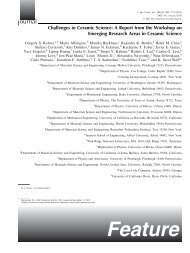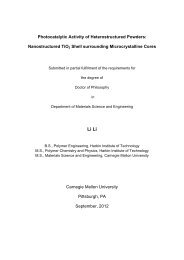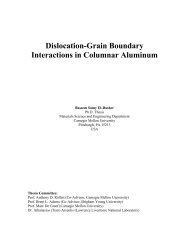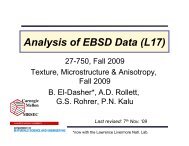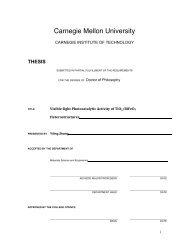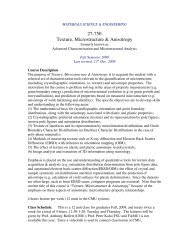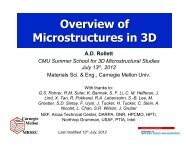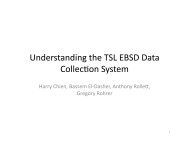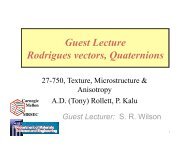¶ 3. Mathematical Representation of Crystal Orientation, Misorientation
¶ 3. Mathematical Representation of Crystal Orientation, Misorientation
¶ 3. Mathematical Representation of Crystal Orientation, Misorientation
Create successful ePaper yourself
Turn your PDF publications into a flip-book with our unique Google optimized e-Paper software.
Let’s take the example <strong>of</strong> the 2-fold symmetry on the x-axis which is best understood as<br />
the limiting case <strong>of</strong> θ→∞ for [1,0,0]tanθ/2. If we consider a point lying on the symmetry<br />
plane at x=-1, i.e. ρ A = [-1,ρ 2,ρ 3], then the action <strong>of</strong> the symmetry operator is to take it to<br />
the following new point, ρ C:<br />
ρC = −1,ρ 2 ,ρ [ 3]<br />
+ tanθ / 2[ 1,0, 0]<br />
− tan θ / 2[0, ρ3 ,−ρ 2 ]<br />
1+ tanθ / 2<br />
As we take this to the limit <strong>of</strong> θ→∞ then ρ C tends towards the point [+1,ρ 3,-ρ 2] which is<br />
the original point reflected through x=0 but also turned through 90°! By considering a<br />
point that is just inside the “back plane” (x=-1), i.e. ρ A = [-1+ε,ρ 2,ρ 3], then evaluation <strong>of</strong><br />
the same combination shows that the related point lies just outside the front plane, x=+1,<br />
and vice versa. Note that the planes associated with the symmetry elements are not<br />
mirror planes, as we are accustomed to seeing them in stereographic projections <strong>of</strong> point<br />
groups, for example.<br />
8/27/09 36



